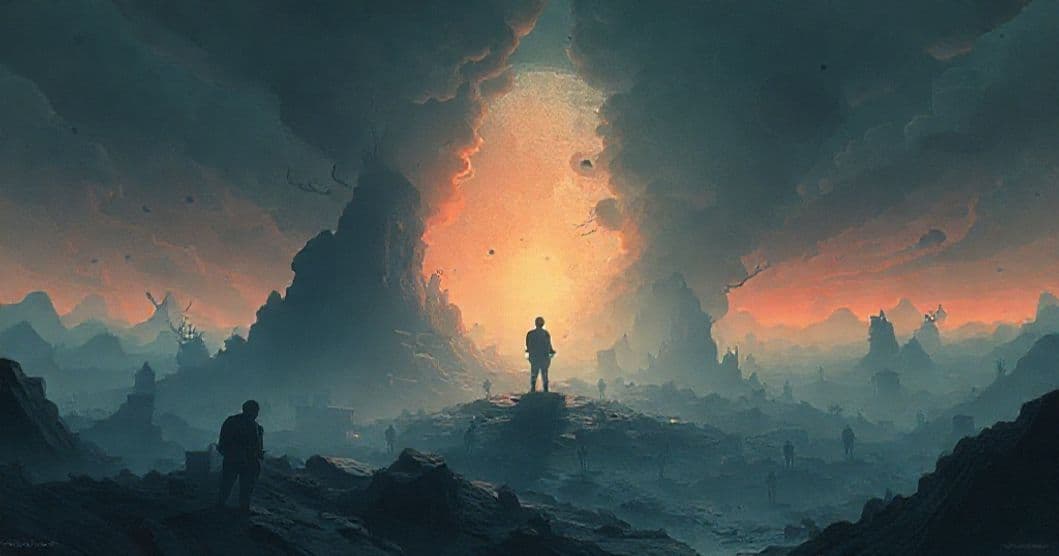Part 1: Dream Presentation
Dreams often arrive unannounced, carrying symbolic messages from our deeper consciousness. Consider this vivid dream experience: it unfolded in three distinct, surreal acts that defied logical cohesion yet collectively painted a portrait of existential unease and primal fear. The dream begins in a sun-baked desert, where a Sons of Anarchy–like biker gang struggles for survival. Their leader, a figure uncannily like Jax Teller, erupts in violence when challenged, while another member—resembling Chibs—breaks into tears, unable to lead. The scene shifts to a warzone where the dreamer, a special forces soldier, fights a chaotic enemy. A disturbing twist occurs when a child is forced to wield a knife against civilians, triggering mass panic and moral collapse. The dreamer and comrades devolve into mindless killers, including a former J-pop idol, Yokoyama Yui, lost in bloodlust. Finally, the dream ends with the dreamer awakening to a broken computer and power outage, blurring the line between sleep and wakefulness.
Part 2: Clinical Analysis
Symbolic Landscape: The Erosion of Human Connection
Want a More Personalized Interpretation?
Get your own AI-powered dream analysis tailored specifically to your dream
🔮Try Dream Analysis FreeThe desert biker gang serves as a powerful metaphor for leadership failure and group dynamics under duress. The leader’s violent outburst represents the collapse of authority when trust and resources vanish, while Chibs’ tearful resignation mirrors the psychological toll of responsibility in crisis. This mirrors Jung’s concept of the shadow—the repressed, primitive aspects of the self—manifesting as raw, unbridled aggression. The warzone, however, escalates this into societal collapse: the militia/civilians as a collective threat to order, yet the dreamer’s unit’s sudden bloodlust reveals the death drive (Freud) or Thanatos (Jung)—the unconscious urge toward destruction. The child forced to kill embodies the archetype of innocence corrupted, a common motif in dreams reflecting moral compromise.
Yokoyama Yui’s unexpected appearance is particularly striking. As a former J-pop idol, she likely symbolizes an idealized self or lost purpose—the dreamer’s admiration for her public persona contrasts sharply with her feral state, representing the shadow’s infiltration of cherished ideals. Her presence in the bloodlust underscores the universality of violence: no role or identity is immune to primal urges when systems fail. The forest, as a liminal space between conscious and unconscious, becomes the collective unconscious itself, where the voice ‘There’s nothing to die for’ echoes the existential vacuum of post-collapse humanity.
Psychological Currents: Trauma, Shadow Integration, and Cognitive Processing
Freud would interpret this dream as a regression to primitive instincts—our deepest fears of chaos and loss of control. The dreamer, though never in combat, processes collective anxieties about societal breakdown, perhaps triggered by news cycles, political polarization, or personal identity crises. Jung’s perspective, however, frames it as a mandala of the unconscious: the three-part structure reflects the psyche’s attempt to integrate fragmented aspects of self—leadership, violence, and idealism—into a cohesive whole.
Modern neuroscience adds context: dreams like this often occur during REM sleep, processing emotional memory and trauma. The disjointed narrative may represent the brain’s attempt to make sense of disconnected stressors—work pressure, relationship strain, or societal unrest—by weaving them into a single symbolic experience. The computer’s glitching screen and power outage mirror the dreamer’s own psychological state: a barrier between reality and unconscious, temporarily failing to function as a bridge.
Emotional & Life Context: Unpacking the Dreamer’s Internal Landscape
The dream’s recurring themes of loss of value and meaninglessness suggest the dreamer may be grappling with existential questions: What gives life purpose? How do we maintain moral integrity when systems fail? The J-pop idol’s inclusion hints at a loss of idealism—perhaps disillusionment with celebrity culture, or a broader sense of societal values crumbling. The forced child soldier scenario reflects fears of being manipulated into violence, or the dreamer’s own struggle with moral compromise in daily life.
The three-part structure may correspond to emotional states: the desert (isolation, leadership failure), the war (action, moral collapse), and the awakening (confusion, disconnection). The dreamer’s waking life likely involves periods of overwhelm—work stress, relationship tension, or anxiety about global events—all manifesting in this apocalyptic vision.
Therapeutic Insights: Navigating the Shadow and Reclaiming Meaning
Dreams like this are invitations to explore the shadow self—the parts of ourselves we fear or repress. The ‘kill until you die’ mentality represents unprocessed anger or rage, possibly toward unmet needs or unacknowledged losses. Journaling about these violent dreams can help identify triggers and normalize the expression of such emotions without judgment.
The dream’s message—‘There’s nothing to die for’—is less about despair and more about re-evaluation. It urges the dreamer to ask: What values do we have that transcend survival? What small acts of connection or creation still matter? Therapeutically, this dream suggests integrating the ‘feral’ aspects of self into a balanced whole—acknowledging anger without letting it consume us, honoring idealism without blind faith.
FAQ Section
Q: Why were the three dream segments so disconnected?
A: Dreams often reflect disjointed emotional states, not logical narrative. The three parts likely represent separate stressors (leadership, violence, identity) processed simultaneously.
Q: What does Yokoyama Yui’s inclusion mean?
A: She symbolizes a lost ideal or repressed self—her presence in bloodlust suggests the shadow’s infiltration of cherished values, urging integration of light and dark.
Q: How should I respond to the ‘nothing to die for’ message?
A: This is a call to redefine purpose. Identify small, meaningful actions (connection, creativity, compassion) that restore value beyond survival.
